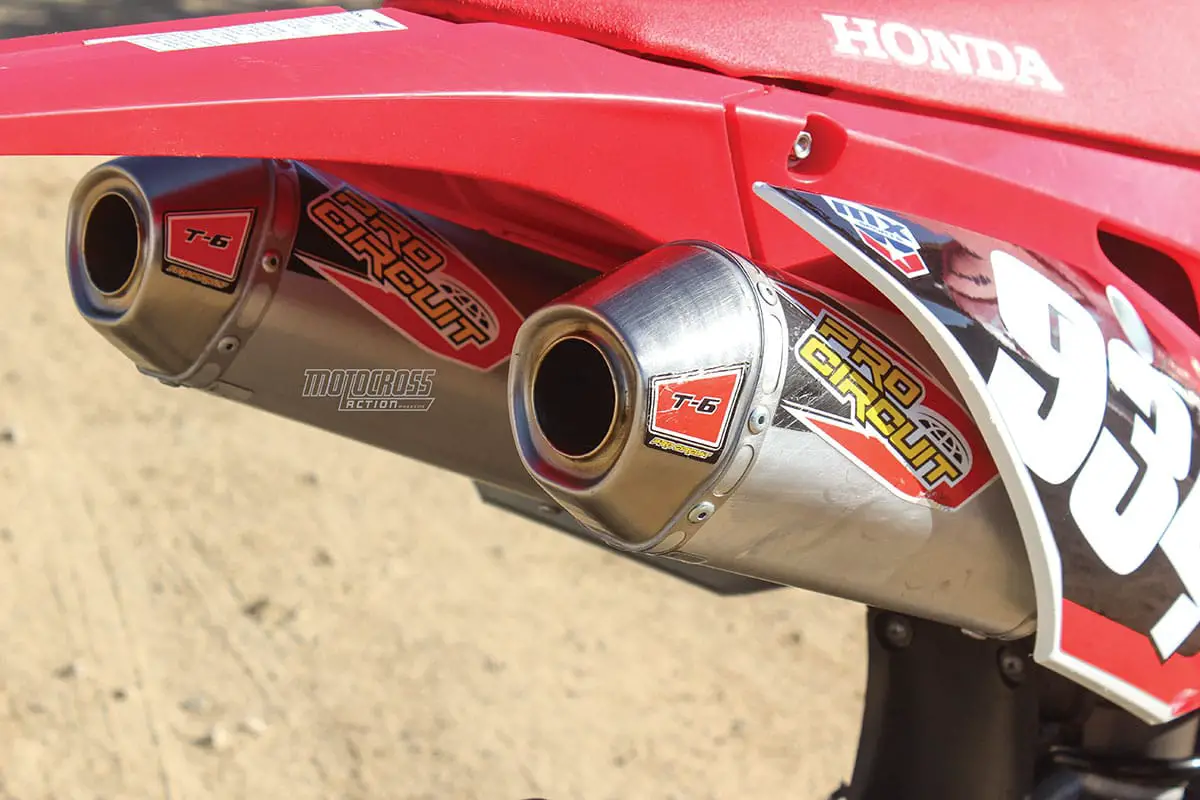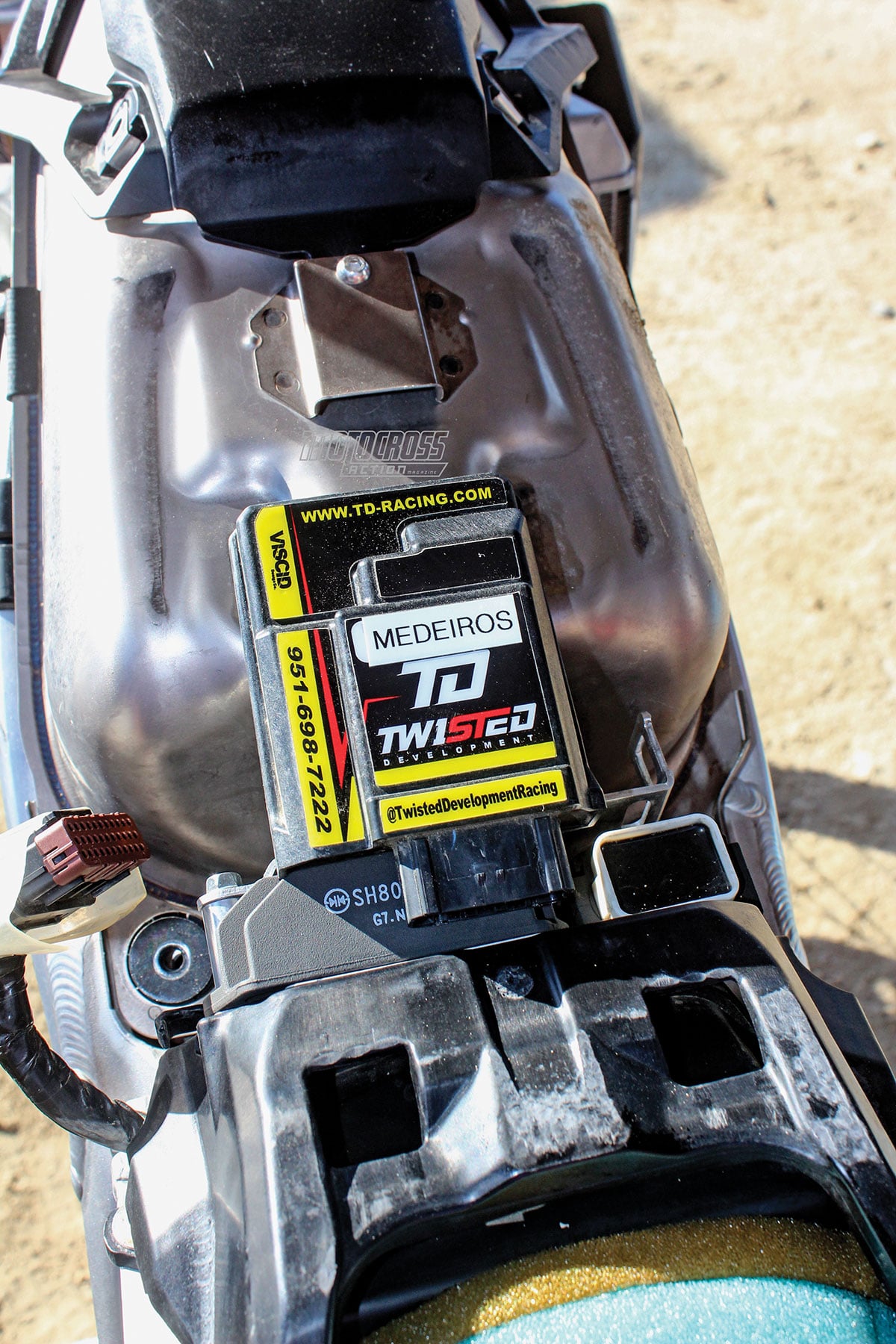FIVE STEPS TO HONDA CRF250 MOTOCROSS NIRVANA
FIVE STEPS TO HONDA CRF250 MOTOCROSS NIRVANA
By Brian Medeiros
It is no secret that the 2018-2020 Honda CRF250 in stock trim has some serious powerband issues. If you ride the bike under 10,000 rpm, as many lower-level riders do, the CRF250 has trouble getting on the pipe out of tight corners. Plus, you have to wring out the rev limiter to get all the Honda has to offer. On big, wide-open tracks, a skilled rider can get the CRF250 into the meat of its powerband and keep it there, but what do you do when you get to a tighter track and it goes, “Wah, wah, wah,” out of a corner? Here are five things that the MXA wrecking crew has done to our 2019 CRF250 to improve the bottom-end performance. We tested each of these parts and pieces one at a time before putting them together as an overall package. Here are MXA’s five steps to Honda CRF250 nirvana.

STEP 1: The first mod we made was to install a Pro Circuit full T-6 dual system. The Pro Circuit system bolted right up to the bike using all the stock nuts and bolts. Immediately upon hitting the track for the first time, we noticed a significant gain in torque from zero to a quarter throttle, which is where we were looking for improved thrust. On short straights, getting from corner to corner was quicker, as the power picks up sooner and with more gusto with this exhaust system. It allowed us to rely on the power of the engine without having to fan the clutch.

STEP 2: Our second step was a cheap and easy mod. On the CRF250, the backfire screen is snapped into the air filter cage. To remove the backfire screen and its effect on throttle response, locate the small tabs that are bent over the plastic to hold the screen in place. With a flat-bladed screwdriver, you can bend those tabs up and remove the screen without having to cut it out. The backfire screen prevents flame from belching back into the airbox and setting the air filter on fire. Luckily, Twin Air makes backfire-resistant air filters and DT-1’s filter oil is flame-resistant to eliminate this danger. On the track we could feel the benefit of the unimpeded airflow throughout the powerband. Without the backfire screen, more air can flow into the intake with less resistance, essentially increasing power without having to spend a dime.

STEP 3: The 2019 CRF250 comes stock with 13/48 gearing. It worked great on wide-open tracks, but we found ourselves shifting down to second gear and even first gear in many tight corners. We bolted on a SuperSprox 49-tooth rear sprocket. With the added tooth, we achieved two positive traits: (1) We didn’t have to downshift so aggressively in corners to ensure solid drive out of them and (2) we were able to stay in a higher gear going into most corners and get the CRF250 up in the rpm range quicker to allow us to shift up on the exit.

STEP 4: After the first three modifications, we were happier with the added low-to-mid power of our CRF250; however, test riders complained that the bike fell flat as it transitioned into the top-end. From past experience, we knew that mapping could fix this issue. We called Twisted Development to see what they could do for us. They offered two services: (1) A re-map of the stock Honda ECU. (2) The installation of a Vortex aftermarket ECU. The remapped stock box costs a lot less money but doesn’t offer as much tunability as you get with the aftermarket ECU.
We elected to remap the stock Honda ECU, because we felt that this option was more in the financial ballpark of most riders. After getting the ECU back from Twisted Development, we headed to the track to try it out. We immediately noticed that the power was now spread out across the entire power curve. It rejuvenated the mid-to-top-end powerband while keeping the bottom-end torque that we gained with the Pro Circuit exhaust, lower gearing and modified backfire screen.

STEP 5: As a final step, we ran VP Racing T4 race gas ($16 per gallon). It is designed for stock or slightly modified four-stroke engines. VP T4 is a direct pour-in replacement for premium pump gas and doesn’t contain ethanol. At 97 octane, T4 provides greater protection against detonation and eliminates any issues with faulty pump gas. With a high-rpm engine, pump-gas instability and variances can wreak havoc on hopped-up engine packages. On the track, we felt the bike had improved throttle response and added power throughout the entire power curve. It is literally pour-in power.
Obviously, there are lots of ways to make your Honda CRF250 run better—and it isn’t unusual for aspiring amateurs and privateers to spend $5000 on an engine package that boosts the power by as many as 5 horsepower with high-compression pistons, valves, cylinder heads, beryllium valve seats, camshafts, stiffer valve springs, coated tappets, black boxes and transmission coatings. We didn’t want to go whole hog on our CRF250, though. We just wanted to fix the powerband flaws that bothered us, because overall we like the CRF250 package. As for the cost, apart from the Pro Circuit T6 exhaust system, we spent under $200. Best of all, these five steps made our 2019 Honda CRF250 engine leaps and bounds better throughout the entire power curve. With the added power, we were able to take advantage of the awesome chassis characteristics of this bike.







Comments are closed.